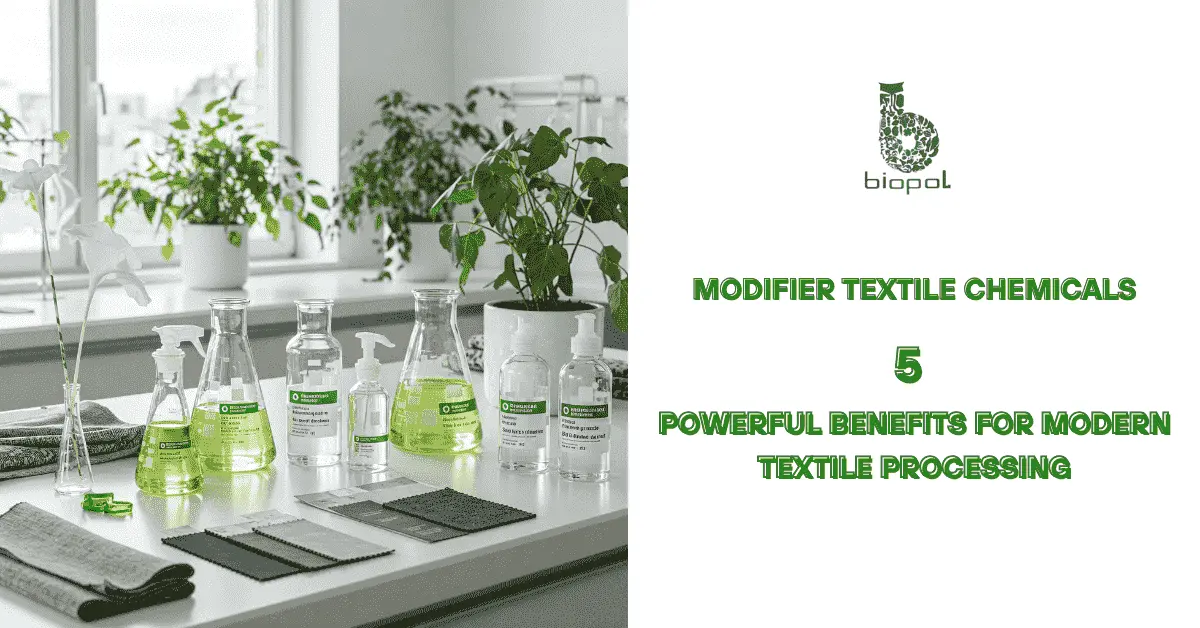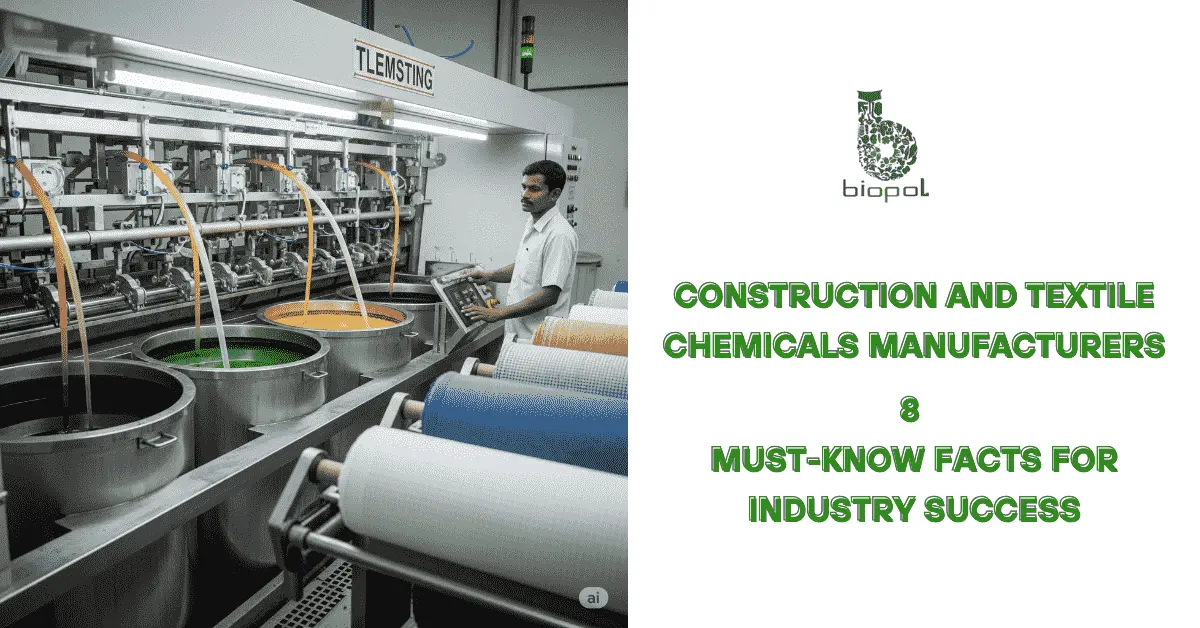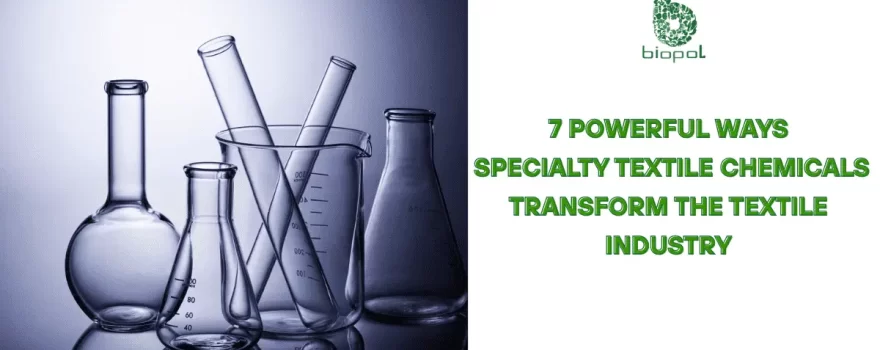
Specialty textile chemicals are the secret heroes of the textile industry. They function as the key ingredient that metamorphoses unprocessed fabrics into the trendy, durable, and practical garments we wear on a daily basis. From enhancing color vibrancy to improving fabric performance, these specialized chemicals play a crucial role in the modern textile sector.
Table of Contents
What are Specialty Textile Chemicals?
Think of specialty textile chemicals as the magicians of the textile world. They possess the power to work wonders, adding value and innovation to every stage of the textile manufacturing process. From dyeing and finishing to printing and coating, these chemicals are essential for creating high-quality, high-performance textiles.
History of Specialty Textile Chemicals
The journey of specialty textile chemicals is a fascinating one, spanning centuries of innovation and discovery. From the ancient Egyptians using natural dyes to the modern-day marvels of nanotechnology, these chemicals have continually evolved, shaping the course of the textile industry.
The Industrial Revolution represented a significant milestone, characterized by the introduction of synthetic dyes and finishes. These innovations revolutionized the textile industry, enabling mass production of affordable, brightly colored fabrics.
Today, specialty textile chemicals are more sophisticated than ever. Their objective is to develop materials that are not only attractive but also functional, eco-friendly, and capable of high performance. From flame-retardant finishes to water-repellent coatings, these chemicals play a vital role in meeting the diverse needs of modern consumers.
Applications of Specialty Textile Chemicals
Specialty textile chemicals are the workhorses behind many industries, enabling innovation and performance across diverse sectors. They impact the following:
Fashion Industry
Color Enhancement: Dyes and pigments add vibrant hues to fabrics, setting trends and captivating consumers.
Performance Finishes: Water-repellent, stain-resistant, and wrinkle-free finishes enhance the durability and ease of care of garments.
Soft Hand Feel: Softeners and conditioners improve the tactile experience of fabrics, making them comfortable to wear.
Automotive Industry
Interior Fabrics: Flame-retardant and stain-resistant treatments ensure safety and longevity of car interior fabrics.
Technical Textiles: High-performance fibers and coatings are employed in the development of airbags, seatbelts, and various safety components. These materials also hold considerable importance in the healthcare industry.
Healthcare Industry
Medical Textiles: Antibacterial and antimicrobial finishes prevent infection and promote hygiene in medical garments and dressings.
Protective Apparel: Water-repellent, chemical-resistant, and flame-retardant fabrics safeguard healthcare workers.
Smart Textiles: Conductive and sensor-integrated fabrics enable wearable health monitoring devices.
Construction Industry
Geotextiles: High-strength, permeable fabrics stabilize soil and reinforce structures.
Building Fabrics: Flame-retardant, water-repellent, and UV-resistant fabrics protect buildings and infrastructure.
Interior Textiles: Durable, stain-resistant, and sound-absorbing fabrics enhance the comfort and aesthetics of indoor spaces.
With the ongoing evolution of technology, the importance of specialty textile chemicals is anticipated to expand. These versatile chemicals are essential for creating innovative, sustainable, and high-performance textiles that meet the evolving needs of modern society.
Categories of Specialty Textile Chemicals
Specialty textile chemicals can be broadly categorized into several types, each playing a specific role in the textile manufacturing process:
Dyes and Pigments
- Reactive Dyes: These dyes create covalent bonds with the fiber, which contributes to their colorfastness and exceptional wash fastness.
- Disperse Dyes: While these dyes are not soluble in water, they can break down into fine particles that effectively penetrate synthetic fibers, including polyester and nylon.
- Acid Dyes: These dyes, which dissolve in water, are primarily intended for the dyeing of wool, silk, and nylon fibers.
- Basic Dyes: These dyes are cationic and have a high affinity for anionic fibers like acrylic.
Finishes
- Mechanical Finishes: These finishing processes involve physical processes like calendaring, embossing, and sanding to impart specific properties to fabrics with the help of specialty textile chemicals.
- Chemical Finishes: The application of chemical agents is involved in these finishes to change the surface properties of fabrics. Some common chemical finishes include:
- Water Repellent Finishes: These finishes create a hydrophobic barrier on the fabric surface, preventing water absorption.
- Flame Retardant Finishes: These finishes reduce the flammability of fabrics by inhibiting combustion.
- Antimicrobial Finishes: These finishes prevent the growth of bacteria and fungi on fabric surfaces.
- Soft Finishes: These finishes enhance the tactile quality of fabrics, rendering them softer and more pleasant to the touch.
Protective Treatments
- UV Protection: These treatments safeguard textiles against the detrimental impacts of ultraviolet radiation, thereby averting color loss and material deterioration.
- Anti-static Treatments: These treatments reduce static buildup, preventing the clinging of fabrics and attracting dust.
- Mildew Resistance: These treatments prevent the growth of mildew and mold on fabrics, especially in humid conditions.
Through an understanding of the different categories of specialty textile chemicals and their uses, textile manufacturers innovate and produce high-performance fabrics that satisfy the wide-ranging needs of consumers.
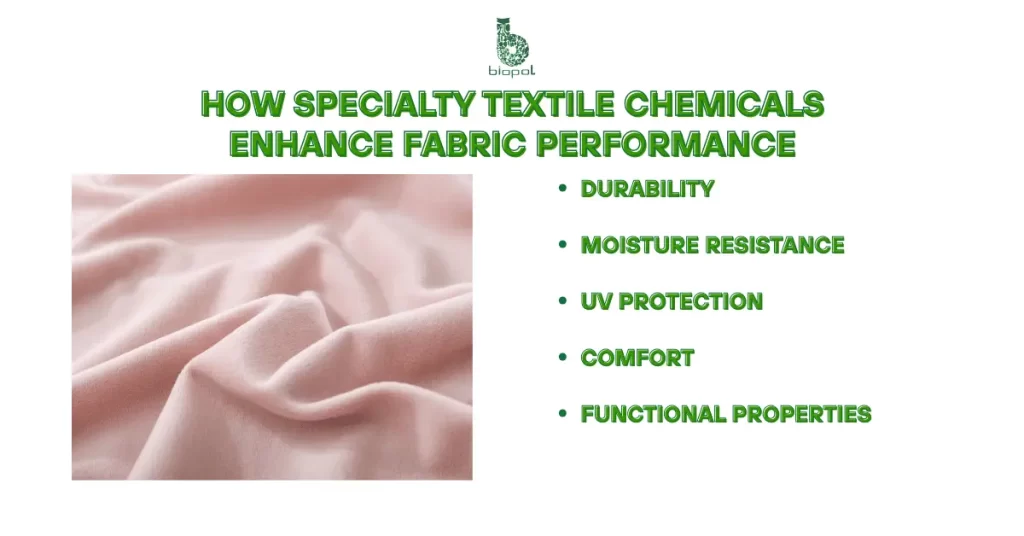
How They Improve Textile Performance
Specialty chemicals also elevate textile performance to new heights. These innovative compounds work their magic by imparting a range of desirable properties to fabrics, enhancing their durability, comfort, and functionality.
Durability
- Anti-pilling agents: These chemicals reduce the formation of pills or fuzz on fabric surfaces, extending the lifespan of garments.
- Anti-abrasion agents: By strengthening the fiber structure, these chemicals increase resistance to wear and tear.
Moisture Resistance
- Water-repellent finishes: These coatings form a protective layer on the fabric’s surface, inhibiting water absorption and ensuring that you remain dry.
- Moisture-wicking finishes: These procedures eliminate moisture from the skin, allowing you to feel both cool and dry.
UV Protection
- UV-blocking agents: These chemicals absorb or reflect harmful UV rays, protecting the fabric and the wearer from sun damage.
Comfort
- Softeners: These substances enhance the tactile quality of textiles, rendering them softer and more pleasant to the touch on the skin.
- Anti-static agents: These chemicals reduce static cling, preventing discomfort and improving the overall wear experience.
Functional Properties
- Flame-retardant finishes: These treatments greatly diminish the flammability of fabrics, thereby enhancing their safety for a range of applications.
- Antimicrobial finishes: These agents restrict the development of bacteria and fungi, contributing to improved hygiene and a sense of freshness.
- Soil-release finishes: These treatments contribute to the ease of cleaning fabrics, as they minimize the risk of stains becoming entrenched.
By carefully selecting and applying specialty chemicals, textile manufacturers can create high-performance fabrics that meet the diverse needs of consumers. These innovative solutions are essential for producing durable, comfortable, and functional textiles that enhance our daily lives.
Sustainability in Specialty Textile Chemicals
The textile sector, previously recognized for its detrimental effects on the environment, is currently experiencing a substantial shift towards sustainable practices. Specialty textile chemicals play a crucial role in this shift, driving innovation and reducing the industry’s ecological footprint.
Eco-Friendly Innovations
- Bio-based Chemicals: The use of renewable resources, including plants and microorganisms, for chemical production offers a more sustainable solution compared to conventional petrochemical products.
- Enzyme-Based Technologies: Enzymes, natural catalysts, can replace harsh chemicals in various textile processes, reducing water and energy consumption.
- Water-Saving Technologies: Advanced dyeing and finishing techniques, such as low-liquor dyeing and foam finishing, significantly reduce water usage.
- Energy-Efficient Processes: By optimizing production processes and adopting energy-efficient equipment, the industry can minimize its carbon footprint.
Biodegradable Chemicals
- Natural Dyes: Extracted from plants, minerals, and insects, natural dyes offer a vibrant and eco-friendly alternative to synthetic dyes. These finishes decompose naturally as time progresses, thereby minimizing environmental pollution. Sustainable Production Processes:
- Biodegradable Finishes: These finishes decompose naturally over time, thereby minimizing environmental pollution. Sustainable Production Processes:
Sustainable Production Processes
- Closed-Loop Systems: By recycling water and recovering chemicals, textile manufacturers can minimize waste and conserve resources.
- Zero-Discharge Technologies: These advanced technologies aim to eliminate the discharge of harmful effluents into water bodies.
- Sustainable Sourcing: Sourcing raw materials from sustainable sources, such as organic cotton or recycled polyester, reduces the overall environmental impact.
By embracing these sustainable practices, the specialty textile chemicals industry can contribute to a greener and more sustainable future. With a growing number of consumers recognizing the environmental and social ramifications of their choices, an increase in the demand for sustainable textiles is anticipated.
Challenges regarding Specialty Textile Chemicals
The specialty textile chemicals, despite their vital role in the textile sector, face a number of significant challenges in their life-cycle:
Regulatory Hurdles
- Strict Environmental Regulations: The growing attention to environmental sustainability has prompted the establishment of rigorous regulations that oversee the production, application, and disposal of chemicals used in textiles. Following these regulations can lead to substantial costs and present considerable complexity.
- Changing Safety Standards: Evolving safety standards for workers and consumers necessitate constant updates to product formulations and manufacturing processes.
- International Trade Restrictions: Trade barriers and tariffs can hinder the import and export of specialty chemicals, impacting supply chains and increasing costs.
Environmental Concerns
- Water Pollution: The textile industry is a major source of water pollution, with untreated wastewater containing harmful chemicals often discharged into water bodies.
- Air Pollution: The production and processing of chemicals can lead to emissions that are detrimental to air quality and can further the effects of climate change.
- Resource Depletion: The extraction of raw materials for chemical production can deplete natural resources and harm ecosystems.
Supply Chain Complexities
- Volatile Raw Material Prices: Changes in the prices of raw materials, particularly crude oil and natural gas, may have an impact on the profitability of chemical manufacturers.
- Supply Chain Disruptions: The global supply chain can experience significant disruptions due to factors such as pandemics or geopolitical tensions, which may cause shortages of vital raw materials and completed products.
- Counterfeit and Substandard Products: The proliferation of counterfeit and substandard chemicals can damage the reputation of the industry and pose risks to consumers and the environment.
Meeting these challenges requires a concerted effort from a range of industry stakeholders.
Innovative Solutions
The specialty textile chemical industry is actively seeking innovative solutions to address the challenges it faces. Here are some of the key strategies being employed:
Compliance and Regulatory Adherence
- Robust Regulatory Monitoring: Staying updated on evolving regulations and proactively adapting product formulations and manufacturing processes to ensure compliance.
- Third-Party Certifications: Seeking certifications like OEKO-TEX Standard 100 to validate the environmental and safety standards of products.
- Transparent Supply Chain Management: Implementing traceability systems to monitor the sourcing and usage of raw materials, ensuring ethical and sustainable practices.
Green Chemistry and Sustainable Production
- Bio-based Chemicals: Developing and utilizing chemicals derived from renewable resources like plants and microorganisms to reduce reliance on fossil fuels.
- Water-Saving Technologies: Adopting advanced dyeing and finishing techniques that minimize water consumption, such as low-liquor dyeing and foam finishing.
- Energy-Efficient Processes Allocating resources towards energy-efficient machinery and enhancing production methodologies to minimize energy usage and lower greenhouse gas emissions.
- Waste Reduction and Recycling: Strategies for waste minimization should be implemented, which include the recycling of wastewater and the recovery of valuable chemicals.
Innovative Product Development
- Functional Finishes: The development of multifunctional surface finishes that combine an array of features, including water resistance, stain repellency, and UV protection, into one comprehensive treatment.
- Smart Textiles: Creating intelligent textiles with embedded sensors and electronics for applications in healthcare, sports, and fashion.
- Sustainable Dyes and Pigments: Eco-Friendly Dyes and Pigments: Creating environmentally sustainable dyes and pigments that minimize ecological harm.
- Biodegradable and Compostable Chemicals: Creating chemicals that are capable of naturally breaking down in the environment is crucial for the minimization of pollution.
By embracing these innovative solutions, the specialty textile chemical industry can overcome challenges, reduce its environmental footprint, and drive sustainable growth.
Global Trends

The specialty textile chemical market is undergoing significant transformation, driven by a confluence of factors, including evolving consumer preferences, technological advancements, and increasing regulatory scrutiny.
Key Market Dynamics
- Sustainable and Eco-Friendly Products: Consumers are increasingly demanding sustainable and eco-friendly products. This trend is driving the demand for biodegradable, non-toxic, and low-impact textile chemicals.
- Functional Textiles: The growing interest in performance apparel and technical textiles is fueling the demand for specialty chemicals that impart properties like water repellency, flame retardancy, and antimicrobial protection.
- Digitalization and Automation: Advancements in digital technologies are revolutionizing the textile industry. Digital printing, automation, and data-driven insights are reshaping the demand for specialized chemicals.
- Regulatory Compliance: Increasingly rigorous environmental regulations are motivating manufacturers to adopt sustainable methodologies and formulate eco-conscious chemicals.
Emerging Technologies
- Nanotechnology: Nanotechnology is driving the development of cutting-edge textile finishes that exhibit enhanced attributes, such as the ability to repel water, resist stains, and provide protection from ultraviolet radiation.
- Biotechnology: Chemicals produced from renewable sources are increasingly favored because of their lower environmental footprint.
- Smart Textiles: The fusion of electronics and sensors with textiles is leading to an increased demand for specialized chemicals designed to enhance conductivity, flexibility, and durability.
Evolving Consumer Demands
- Performance and Functionality: Consumers seek textiles that can withstand harsh conditions, provide comfort, and offer specific functionalities like moisture-wicking, temperature regulation, and odor control.
- Sustainability: The significance of ethical and sustainable production methods is growing among consumers. They show a preference for products crafted from environmentally friendly materials and manufactured through sustainable processes.
- Customization and Personalization: Additionally, there is a rising demand for customization and personalization, as consumers seek products tailored to their specific needs and preferences. This trend is propelling advancements in customized textile treatments and finishes.
To capitalize on these trends, specialty chemical manufacturers must focus on innovation, sustainability, and customer-centricity. Through the creation of innovative products, the implementation of sustainable practices, and a keen awareness of changing consumer demands, they can establish a strong foundation for enduring success in the global marketplace.
Economic Impact on Global Trade
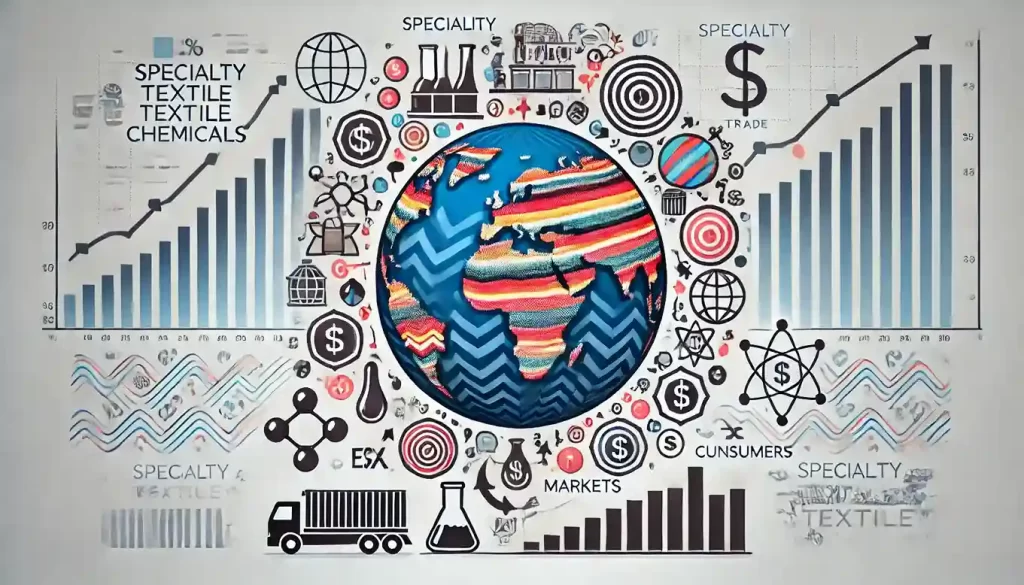
Specialty textile chemicals significantly contribute to the evolution of global trade and the advancement of economic growth. These chemicals enhance the value and performance of textiles, making them more competitive in international markets.
Increased Export Potential
- Enhanced Product Value: Specialty chemicals can significantly improve the quality, durability, and functionality of textiles, increasing their market value.
- Diversification of Export Markets: By enabling the production of high-performance and specialized textiles, these chemicals open up new export markets, particularly in sectors like automotive, healthcare, and sports apparel.
Competitive Advantage
- Product Differentiation: Specialty chemicals allow textile manufacturers to differentiate their products based on unique features and benefits, giving them a competitive edge.
- Cost-Effectiveness: By improving production efficiency and reducing waste, these chemicals can contribute to cost savings and increased profitability.
Economic Growth and Job Creation
- Industrial Development: The specialty chemical industry itself creates jobs in research, development, manufacturing, and sales.
- Stimulating Allied Industries: The demand for specialty chemicals can boost related industries like textile manufacturing, dyeing, and finishing.
- Increased Tax Revenue: The growth of the textile industry, fueled by specialty chemicals, can lead to increased tax revenue for governments.
Conclusion
Specialty textile chemicals are essential for shaping the future of the textile industry. They enable manufacturers to develop cutting-edge products that align with the changing demands of consumers. As technological advancements persist, we can anticipate further revolutionary innovations in specialty chemicals, propelling the industry toward a sustainable and thriving future.
Frequently Asked Questions
What Chemicals Are Used in Textiles?
Chemicals utilized in the textile industry are essential substances that contribute significantly to the processing and finishing of fabrics. These include dyes for coloring, finishing agents for enhancing fabric properties, softeners for improving texture, and flame retardants for safety. These chemicals are essential in creating textiles with specific functionalities like water repellency and antimicrobial properties.
What Chemical Substances Are Produced by the Textile Industry?
Chemical products in the textile industry are substances used during textile processing to enhance or modify the fabric’s characteristics. These include dyes, pigments, finishing agents, sizing agents, and softeners. These substances enhance the longevity, aesthetic appeal, and comfort of textiles, rendering them appropriate for a wide range of uses.
What Are Specialty Chemicals and Fine Chemicals?
- Specialty Chemicals: These are chemicals designed for specific, high-performance applications within industries like textiles. They are specifically crafted to augment the properties of fabrics, such as their color, texture, and longevity.
- Fine Chemicals: These are highly pure chemicals used in specialized processes, such as in pharmaceuticals or high-tech industries. Fine chemicals are typically manufactured in smaller volumes with greater accuracy.
What Is the Difference Between Chemicals and Specialty Chemicals?
- Chemicals: Chemicals are general-purpose materials utilized in numerous industries for diverse applications.
- Specialty Chemicals: Chemicals are general-purpose materials utilized in numerous industries for diverse applications.
List 2 Chemicals in Textiles
Formaldehyde: Applied in fabric finishes to make textiles wrinkle-resistant and durable.
Sodium Hydroxide: Used in textile bleaching and cleaning processes.
Also Read: Textile Chemicals: The Secret Sauce Behind Your Clothes
